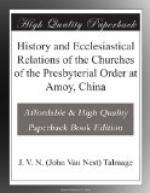The Board of Foreign Missions, being simply the organ of Synod, felt bound in their Report to eliminate, as far as possible, all the Presbyterian elements from the above Reports of the Mission. By so doing, we think that they, undesignedly of course, keep our Church in ignorance, not only of the absolute unity of the Churches in the region of Amoy, but also of the real progress of the cause of Christ and of the Church of our order there. Among the members set down to our churches are those who belong to stations under the care of the English Presbyterian Mission, as is shown by the Tabular Views. The Church at home, not aware of this fact, gives to their Mission credit which does not belong to them; and then, when, in the progress of the work, new churches are organized at these stations, and these members are set off to them, because they belong there, the Dutch Mission is charged with deficiency of denominational feeling, in giving to the English Presbyterians that which, “by all rules of Christian courtesy and harmonious Missionary action,” belongs to the Dutch Church. Is it well that we should be disputing among ourselves concerning who shall have that credit which all belongs to Christ? I know it has been asked, with disapprobation, by very high authority (not, indeed, by the Board) concerning the unity of the Churches at Amoy—“how it came to exist at all.” In answer to such questions, let us consider one case, that of the Station, now Church, at E-mng-kang. It is near enough to the First Church, at Amoy, to be under its supervision. Doubtless, we might have said to our Presbyterian brethren, In gathering a church, we are willing to labor with you in preaching the Gospel, for no one will censure us for that, and we admit that, by all principles of our Church order, it would be altogether proper that the converts gathered in at E-mng-kang should be received and watched over by the First Church, at Amoy; but, by allowing this, there will be danger of unity between the Christians at E-mng-kang and Amoy ("that they all may be one"), which will be a violation of the important and radical distinction existing between them, because “some are supported by our funds, some by the funds of the English Presbyterians;” and then, when it becomes necessary to divide these Churches, for where there is such a radical distinction, “a division will necessarily come at some period, and the longer it is delayed, the more trying and sorrowful it will be,” it will be found that the Church at Amoy can never “relinquish its powers and abnegate its authority” over the Church at E-mng-kang—therefore, rather than incur such risks of unity, we had better violate our principles of Church order at the commencement, and not allow the native Elders any responsibility in receiving and watching over the Church members. We might have acted on such principles, but shall we be censured for not doing it?




